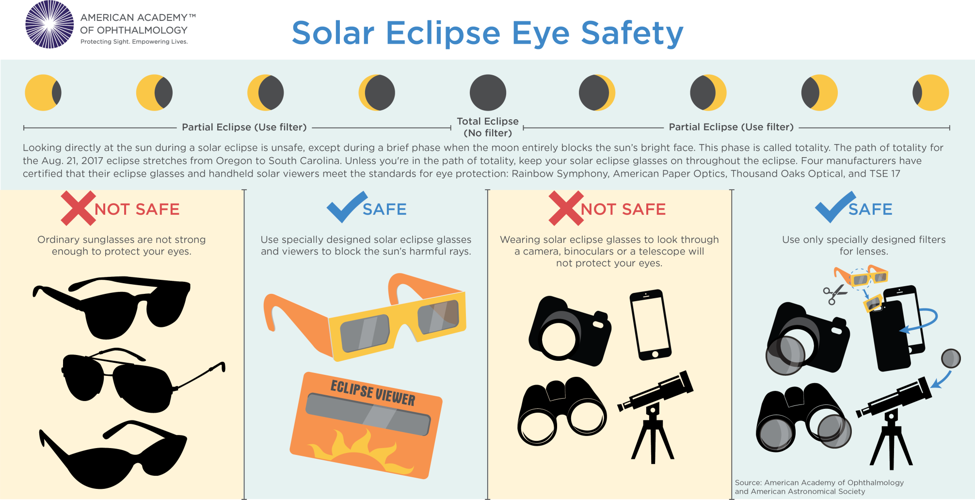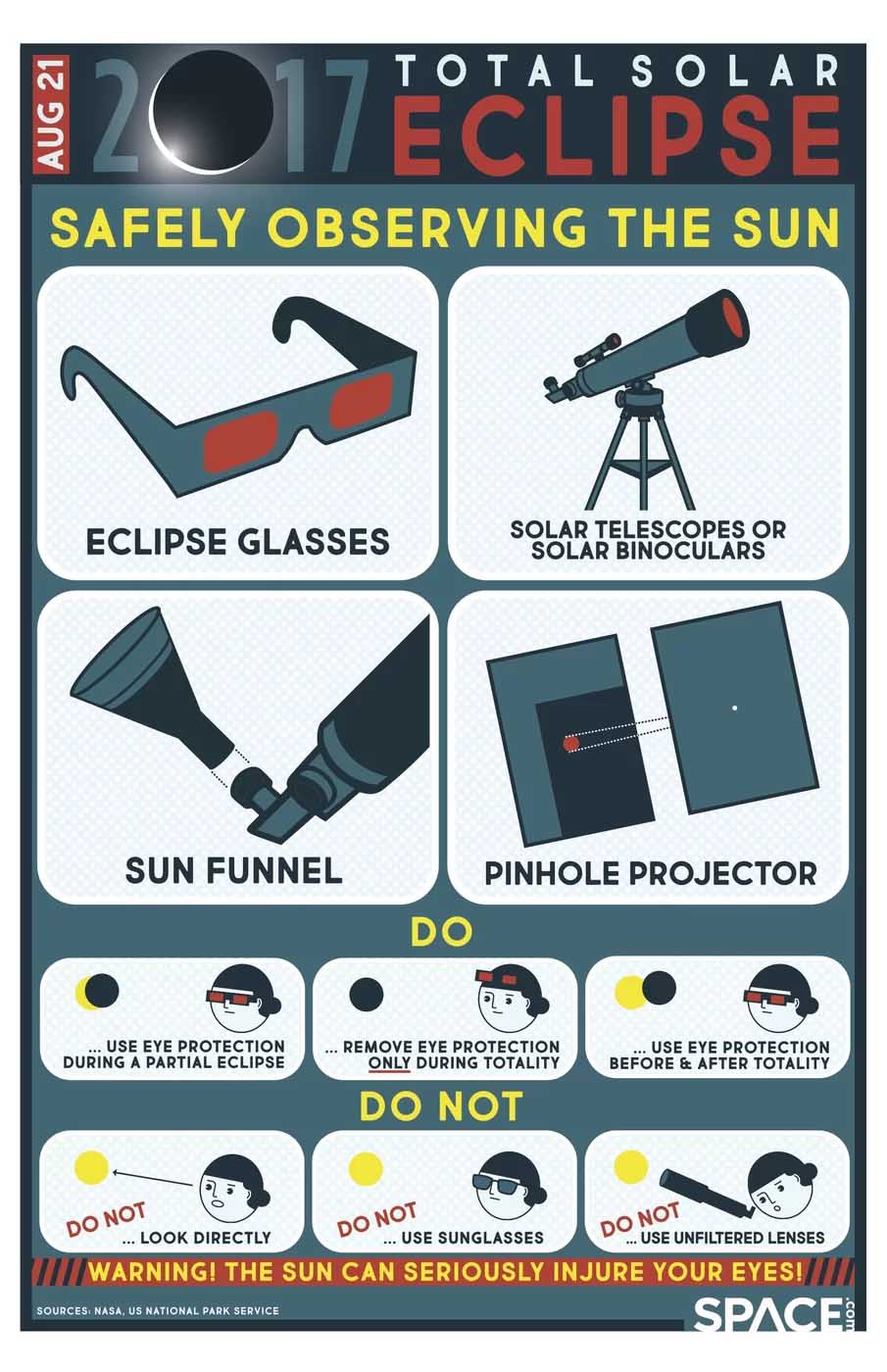Thinking about staring directly at the sun during an eclipse? Don't even consider it! The dangers are real, and the consequences can be devastating, potentially leading to permanent eye damage, even blindness.
The allure of witnessing a solar eclipse is undeniable. Millions across the United States were captivated by the celestial spectacle on Monday, April 8, eager to experience this rare astronomical event firsthand. However, this excitement must be tempered with caution. The path to safely viewing an annular eclipse differs significantly from that of a total solar eclipse. Understanding these distinctions is paramount to protecting your vision.
To provide a comprehensive overview of the dangers associated with viewing a solar eclipse, and how to mitigate those dangers, consider the table below with additional safety measures and key information.
- Bam Margeras Wild Ride From Jackass Star To Recovery Journey
- 2025 Indian Streaming Scene Mustwatch Hindi Web Series
| Category | Information |
|---|---|
| Event Types | Annular Solar Eclipse, Total Solar Eclipse, Partial Eclipse |
| Date of Eclipse | April 8, 2024 (Total Solar Eclipse across North America) |
| Primary Danger | Permanent eye damage, including blindness and solar retinopathy ("eclipse blindness") |
| Safe Viewing - Total Eclipse | Only during the brief total phase, when the moon completely blocks the sun, can the eclipse be viewed safely with the naked eye. |
| Unsafe Viewing - Partial/Annular | Never safe to look at a partial or annular eclipse, or partial phases of a total eclipse, without proper equipment. |
| Safe Viewing Equipment | ISO 12312-2 compliant solar eclipse glasses or handheld solar viewers. |
| Damage Risks | Total blindness, loss of central vision, distorted vision, altered color vision. |
| Alternative Viewing | Livestream broadcasts of the eclipse. |
| Study Reference | Study of 20 people (ages 15-82) in England with vision complaints after an eclipse. |
| Expert Warnings | Doctors and eclipse watchers warn about viewing without adequate protection. |
| Additional Reference | NASA Eclipse Website |
The stark reality is that the way to safely observe an annular solar eclipse is fundamentally different from how one might approach a total solar eclipse. Learning how to view the 2023 annular solar eclipse (which has passed) and preparing for the April 8, 2024, total solar eclipse required distinct safety measures. Except during the fleeting total phase of a total solar eclipse, when the moon perfectly obscures the sun's intensely bright face, it is unequivocally unsafe to look directly at the sun.
The misconception that an eclipse allows for safe viewing of the sun is a dangerous one. The lunar disk doesn't shield all harmful radiation, and even when 99% of the sun's surface is covered, the remaining sliver of light can inflict severe damage. The only instance when the sun can be viewed safely with the naked eye is during the totality of a total solar eclipse, when the moon completely cloaks the sun's disk. It's critical to reiterate that it's never safe to look at a partial or annular eclipse, or the partial phases of a total solar eclipse, without employing the correct protective equipment and techniques.
Why is looking directly at a solar eclipse so dangerous for your eyes? The answer lies in the intensity of the sun's radiation. Even when a significant portion of the sun is obscured, the remaining light can still cause photochemical damage to the retina, the light-sensitive tissue at the back of the eye. This damage can manifest as solar retinopathy, often referred to as "eclipse blindness."
- New Web Series Movies What To Watch Date Streaming Guide
- Who Are Storm Reids Parents Family Career Support
On April 8, 2024, the solar eclipse captivated millions of Americans, igniting a desire to witness this celestial spectacle firsthand. However, this enthusiasm needs to be tempered with a firm understanding of the risks involved. Viewing the eclipse without proper eye protection can lead to serious and irreversible eye damage. It's essential to know why staring at a solar eclipse can harm your eyes and what preventative measures to take.
The phenomenon of a solar eclipse occurs when the moon passes between the sun and Earth, effectively blocking the sun from our view. This process unfolds over a span of a couple of hours. Initially, a partial eclipse occurs as the moon gradually begins to cover the sun's bright face. The anticipation builds as more and more of the sun is obscured, creating an ethereal and awe-inspiring sight. However, it is during these partial phases that the risk of eye damage is at its highest.
In the lead-up to the April 8 solar eclipse, doctors and seasoned eclipse observers issued repeated warnings about the dangers of watching this planetary event without adequate eclipse glasses or with the naked eye. The consequences can be severe and long-lasting. In 2017, during the solar eclipse that traversed the United States, numerous individuals suffered eye damage despite widespread media coverage highlighting the risks of looking at the sun without protection.
The dangers of viewing a solar eclipse are not to be taken lightly. Looking at a solar eclipse with the naked eye significantly increases the chances of incurring permanent eye damage, including total blindness, loss of central vision, distorted vision, and altered color vision. One of the most common effects is "eclipse blindness," or solar retinopathy, a condition where the retina is damaged by the intense solar radiation.
A patient page published online in JAMA (Journal of the American Medical Association) provided safety recommendations for viewing the April 8 total solar eclipse, which crossed major U.S. cities. The publication emphasized that while a solar eclipse can be one of natures most extraordinary astronomical displays, improper viewing can cause serious eye damage, even blindness, if certain precautions are not taken. Ophthalmologists are well aware of the potential for harm, and their warnings should be heeded.
What steps can be taken to ensure safe viewing? First and foremost, do not look directly at the eclipse at all. Seek out alternative, safe ways to experience the eclipse, such as watching a livestream broadcast. If you choose to use safe solar eclipse viewers, read and carefully follow all manufacturers' directions. Time was of the essence leading up to the eclipse on April 8, so securing proper eye protection was paramount.
Age offers no guarantee of safe eclipse viewing. A study documented 20 individuals, ranging in age from 15 to 82, in England who reported symptoms such as black spots in their vision or blurry vision after an eclipse. The study underscored the common misconception that an eclipse renders the sun safe to view directly, suggesting that the lunar disk effectively shields the sun's harmful radiation, allowing viewers to safely admire the sun's corona. This is demonstrably false and potentially dangerous belief.
The critical takeaway is this: prioritize eye safety above all else when observing a solar eclipse. The fleeting moments of celestial wonder are simply not worth the risk of permanent vision damage. By following the recommended safety guidelines and employing proper viewing techniques, you can enjoy the beauty of a solar eclipse without compromising your eyesight.
- New Web Series Movies What To Watch Date Streaming Guide
- Brandi Passante From Storage Wars Star To Whats Next


